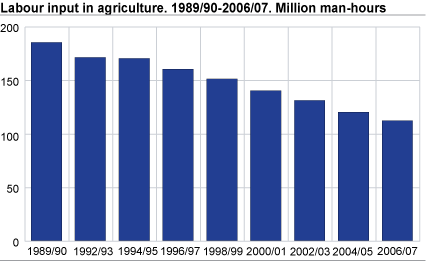Content
Published:
This is an archived release.
Fewer man-hours in farming
The total labour input on holdings with agriculture and horticulture was 111.6 million man-hours in 2006/07. In addition, 10 million man-hours were put into farm forestry and supplementary industries.
The labour input to agriculture and horticulture represents 111.6 million man-hours of the total. The labour input in farm forestry was 3.5 million man-hours, and in supplementary industries 6.5 million. The labour input to agriculture and horticulture in 2006/07 was 8.1 million man-hours less than two years earlier.
Supplementary industries widespread in agriculture
In 2007, 40 per cent of the agricultural holdings were engaged in some sort of supplementary industry in addition to traditional farming and forestry. In this context, supplementary industry refers to an activity that uses the land, buildings or machinery belonging to the holding. The most common activities were machinery-related services, renting out hunting and fishing rights, renting out farm buildings or farmhouses, farm tourism and processing of timber for sale. In total, the gross income from supplementary industries constituted NOK 2.25 billion in 2007.
These figures are quite similar to the preliminary statistics .
Tables:
- Table 1 Labour input in agriculture, forestry and other supplementary industries on holdings, by county. 1 000 man-hours. 2006/07
- Table 2 Labour input in agriculture, by category of manpower and county. 1 000 man-hours. 2006/07
- Table 3 Labour input in agriculture, by sex, category of manpower and county. 1 000 man-hours. 2006/07
- Table 4 Holdings with supplementary industry, by county. 2006/07
- Table 5 Holdings with various supplementary industries by size of gross income from these industries. 2006
- Table 6 Gross income in supplementary industries in agriculture. 2006. NOK 1 000
Contact
-
Berit Bjørlo
E-mail: berit.bjorlo@ssb.no
tel.: (+47) 40 81 13 76
-
Cathrine Gran Øverby
E-mail: cathrine.overby@ssb.no
tel.: (+47) 40 85 46 03

